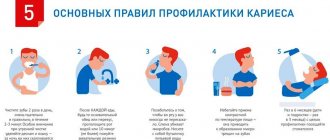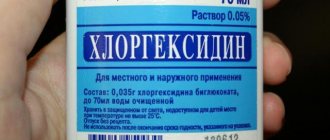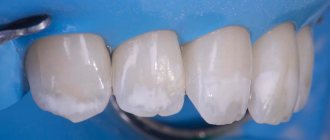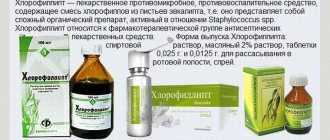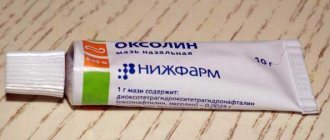Author of the article:
Soldatova Lyudmila Nikolaevna
Candidate of Medical Sciences, Professor of the Department of Clinical Dentistry of the St. Petersburg Medical and Social Institute, Chief Physician of the Alfa-Dent Dental Clinic, St. Petersburg
According to statistics, every second person on the planet has suffered from gum inflammation at least once. It is not surprising: the modern rhythm does not allow us to properly care for the oral cavity; bacteria accumulate between the teeth and begin to actively multiply, which leads to various pathologies.
One of the most popular remedies for gum inflammation is the well-known Miramistin. This powerful solution will quickly destroy harmful bacteria and return you to normal life. But how do you know when it’s time to start rinsing? How to carry out the procedure correctly? Let's figure it out together.
How to rinse your mouth with miramistin for gum inflammation?
To rinse, you need to put 15 ml of undiluted Miramistin in your mouth and start the procedure. When rinsing, it is important to ensure that the gums come into contact with the antiseptic. After rinsing, the drug should be spat out.
Doctors recommend repeating the procedure twice a day for 10 days until the inflammation is eliminated.
How often do dentists use Miramistin?
Miramistin is used in dental practice not only to eliminate gum inflammation. The drug in the form of a spray or solution is used to treat stomatitis, gingivitis, periodontitis, periodontitis, as well as to prevent inflammation after dental treatment or surgery.
Miramistin can also be used to treat removable dentures; the drug is excellent for the treatment of candidiasis and other fungal diseases in adults and children.
- For stomatitis,
Miramistin is suitable both in the form of a spray and in the form of a rinse solution. The spray should be used 3 times a day for 7-10 days, spraying the drug onto the mucous membrane. You can rinse your mouth with Miramistin solution. - For herpetic stomatitis,
it is worth adding antiviral and immunostimulating agents to treatment and rinsing with Miramistin, after consultation with a specialist. - In case of simple inflammation of the gums
, to increase the effectiveness of treatment, rinsing with Miramistin should be supplemented with the removal of tartar.
Does Miramistin have any contraindications?
The drug has virtually no contraindications, but Miramistin is not recommended for use for more than 10 days. Also, people with individual intolerance to the drug should not rinse their mouths with the solution. In very rare cases, Miramistin may cause an adverse reaction in the form of burning and allergies.
What else can you use?
An effective alternative to Miramistin can be Asepta Active mouth rinse. This remedy combines a combination of anti-inflammatory, analgesic components, benzydamine and the antimicrobial component chlorhexidine.
This composition complements the antiseptic effect of the mouthwash by quickly relieving pain, which significantly increases the effectiveness and speed of treatment of gum inflammation.
Why is processing important?
Typically, a tooth is removed if it is so damaged that it cannot be restored. That is, both its visible part and the root are damaged, and at the same time it is not possible to install a reinforcing pin for subsequent prosthetic restoration with a crown. This procedure is possible only when the thickness of the root walls is at least 2 millimeters. If it has been severely damaged by caries, then the tooth has to be removed completely.
What is caries? This is rot, consisting of a mixture of bacteria. If even a small part of them gets into the wound left after tooth extraction, a purulent sac will certainly appear there. Moreover, all this can happen even without a pain symptom, because the dental nerve usually dies before this moment.
If the pus subsequently breaks out, it may result in blood poisoning. There are also cases where, due to bacterial infection of the wound after tooth extraction, the rotting process transferred to the jaw bone. As a result, part of it had to be removed.
And in order to prevent the above complications, the wound is treated with antiseptics and anti-inflammatory drugs. Miramistin solution (0.01%) is ideal for this, since it is active against bacteria, fungi, viruses, and at the same time strengthens local immunity and prevents the activation of the inflammatory process.
Clinical researches
According to the results of clinical trials of the ASEPTA® rinse After 3 weeks of using the ASEPTA® rinse, gum bleeding is reduced by 28.3%, inflammation is reduced by 32.3% and the hygienic condition of the oral cavity is improved by 33.5%.
The mouthwash is designed to protect gums from inflammation and improve oral hygiene and is recommended for use by patients suffering from:
- acute and chronic gingivitis;
- acute and chronic periodontitis;
- stomatitis;
- post-extraction alveolitis;
- toothache of infectious origin.
Sources:
- The role of anti-inflammatory rinse in the treatment of periodontal diseases (L.Yu. Orekhova, A.A. Leontyev, S.B. Ulitovsky) L.Yu. OREKHOVA, Doctor of Medical Sciences, Prof., Head of Department; A.A. LEONTIEV, dentist; S.B. ULITOVSKY, Doctor of Medical Sciences, Prof. Department of Therapeutic Dentistry of St. Petersburg State Medical University named after. acad. I. P. Pavlova
- Report on clinical trials to determine/confirm the preventive properties of commercially produced personal oral hygiene products: mouth rinse "ASEPTA PARODONTAL" - Solution for irrigator." Doctor of Medical Sciences Professor, Honored Doctor of the Russian Federation, Head. Department of Preventive Dentistry S.B. Ulitovsky, doctor-researcher A.A. Leontiev First St. Petersburg State Medical University named after academician I.P. Pavlova, Department of Preventive Dentistry.
- Report on determining/confirming the preventive properties of commercially produced personal oral hygiene products: Asepta toothpaste used in combination with Asepta mouthwash and Asepta gum balm Head. Department of PFS Doctor of Medical Sciences Professor S.B. Ulitovsky St. Petersburg State Medical University named after Academician I.P. Pavlova. Faculty of Dentistry. Department of Preventive Dentistry.
How long can it take to process?
When removing a tooth, the dentist must treat the wound, remove any remaining pus, and tooth fragments. But it does not stop the bleeding. A dense blood clot forms at that site, which acts as a plug, thereby clogging the wound. It protects it from food, moisture, and those same bacteria.
But until that clot “hardens” completely, no manipulations with the wound can be carried out. Any lotions, compresses, or rinses will cause the blood clot to simply become limp and “fall out” of the wound.
How long does it take for the clot to “freeze”? On average - 24-36 hours. During this period, you should eat with caution, brush your teeth (without running a toothbrush over the wound), avoid hot foods (this even applies to baths or showers) and smoking.
It is possible to treat the area where the diseased tooth was previously located only after 36-48 hours. Moreover, it is better to start with ordinary cotton compresses. When rinsing the mouth, there is a high probability that the blood clot will “come out”.
After tooth extraction, the doctor will definitely tell you what the patient should do afterwards. First of all, it is necessary to focus on his instructions, since he assesses both the patient’s condition and the likelihood of damage to the jaw bone. If necessary, he will prescribe an antibiotic and painkiller, and set a day for a re-examination.
Comments
Miramistin is really good, but it’s just expensive, almost 400 rubles for 150 milliliters. What is the best way to replace it?
Cherkassova Dilyara (09.10.2020 at 23:29) Reply to comment
- Dear Dilyara, in terms of the principle of action and set of positive properties, budget drugs such as Chlorhexidine and Furacilin are similar to Miramistin. But before using them, do not forget to consult your doctor, because they have a number of contraindications.
Editorial staff of the portal UltraSmile.ru (10/13/2020 at 09:14) Reply to comment
Write your comment Cancel reply
Miramistin: application in dentistry and ENT
Miramistin not only has a broad effect on most pathogenic bacteria. Unlike most other antiseptics, it also has activity against the herpes virus. This makes it the first choice drug for the treatment of stomatitis in both children and adults. Miramistin instructions for use contain the following indications:
The price of the drug is indicated for 2021. Miramistin can be bought at any pharmacy without a prescription. Miramistin spray and Miramistin solution are sold in Russia. They are produced in the Moscow and Kaliningrad regions.
- Miramistin spray - price from 350 rubles, the volume of the bottle is 150 ml, and the package already includes a spray nozzle. The sprayer allows you to use the bottle not only for rinsing your mouth, but also makes it possible to apply only a small amount of the drug to areas of inflammation. The latter is important in young children.
- Miramistin solution - price from 200 rubles. This form of release is equipped with a urological applicator, and therefore is more suitable for use in urological practice. Although, if you decide to treat your skin with this solution or rinse your mouth, then nothing bad will happen.
- Miramistin ointment - price from 170 rubles; the drug (Fig. 2) is available in a 15 g tube. Unfortunately, at the moment the drug is produced and sold only in Ukraine and some CIS countries.
A few words about the history of the creation of the drug
"Miramistin" as a drug first began to be developed in the distant 70s. At first, it was promoted as a composition that was supposed to be used at interorbital stations to disinfect the skin of astronauts and to treat objects, things, and workplaces around them. However, after the collapse of the USSR, research on the active antiseptic substance miramistin was suspended; they were returned to them again in the late nineties. It was then that the medicine first began to be put on sale, but to solve narrow-profile problems (for example, the prevention of sexually transmitted diseases). There was no talk of him as a child at all.
Miramistin allows you to solve problems in many areas of medicine
Later, additional studies were carried out, which allowed specialists to expand the list of areas of application of the drug. And its safety, almost one hundred percent effectiveness and the absence of contraindications, except for individual intolerance, made it possible to use Miramistin for children.
Today the drug is produced by a production facility located in the Moscow region. The medicine is in demand in Russia, Ukraine, Belarus, Kazakhstan, Turkmenistan, and Armenia. They also plan to sell the product in China soon1.
Now let’s look at the cases in which doctors at dental clinics recommend using the drug. You need to understand that Miramistin is equally often prescribed in both pediatric and adult dentistry as an additional measure to the main treatment. It is not a panacea, but the instructions for its use state that, in combination with other measures, it helps get rid of various problems.
How to use the drug for children and pregnant women
This medicine is often prescribed even to infants, not to mention other children and adults. It's all about the convenient spray nozzle. You simply open the child’s mouth slightly, and the medicine will immediately fall into the pathological focus.
Just a couple of clicks and you've already done your job. At the same time, it is important to ensure that the medicine does not get on the tonsils and throat. It is not recommended for children to swallow the medication.
You can also proceed according to another scheme: soak a cotton swab in liquid and, using large movements, thoroughly wipe the oral cavity.
The most important thing is that there is not too much money. Despite the fact that it has a rather inconspicuous shade and aroma, allergic reactions often occur in children when used systematically.
Women of childbearing age are wondering if it is possible to rinse your mouth with miramistin while pregnant? If you treat only your mouth with this product, it will not penetrate the bloodstream and further into the body. Do not swallow or douche with this drug.
A separate category of specialists does not recommend medicine at all for women in an interesting position. To date, the harmlessness and danger of the medicine have not yet been officially proven.
Purulent pathologies
Often, patients come to dental clinics with a fistula, gumboil, purulent cyst, enlarged granuloma, abscess, osteomyelitis, or even phlegmon. All of the listed pathologies, as a rule, are the result of advanced dental diseases (caries, pulpitis, periodontitis). To get rid of them, doctors perform root canal treatment on the diseased unit or remove the tooth. If there are ulcers in the oral cavity, they are opened with surgical instruments and a drainage is installed through which the pus is washed out.
Treatment is also carried out in the presence of a fistula
For better release of purulent masses, experts often prescribe rinsing with Miramistin, since the drug has a drawing property. It also dries wound surfaces, prevents bacteria from entering them, and promotes rapid healing. Plus, it stops the signs of the inflammatory process and allows the patient to return to normal faster.
Dentists prescribe it precisely for its ability1 to activate local immunity, reduce the inflammatory reaction of tissues and help accelerate the process of their regeneration, and stabilize the pathological process. At the same time, there are no allergic reactions, discomfort, taste disturbances, or changes in enamel color to the drug.
Inflammation of periodontal tissues
The drug is used for antiseptic treatment of the oral mucosa during the treatment of gingivitis, periodontitis and periodontal disease. In combination with other measures (for example, taking antibiotics, brushing teeth from plaque and tartar, plasma lifting and injections of hyaluronic acid, bioactive gels), the product helps relieve inflammation and swelling of tissues, get rid of bleeding and increased sensitivity of the gums.
The drug is used for periodontitis
Stomatitis
The drug is a broad-spectrum antiseptic, fights all types of bacteria, copes with the herpes virus and Candida fungus, which is why it is so often prescribed in the complex treatment of stomatitis, especially herpetic and candidiasis. However, if you suspect stomatitis, you should not prescribe this medicine to yourself or your child, because it is not always effective. So, with an allergic type of pathology, the remedy will not work, and it is almost impossible to determine without the help of a doctor what type of disease you have developed.
The photo shows stomatitis


